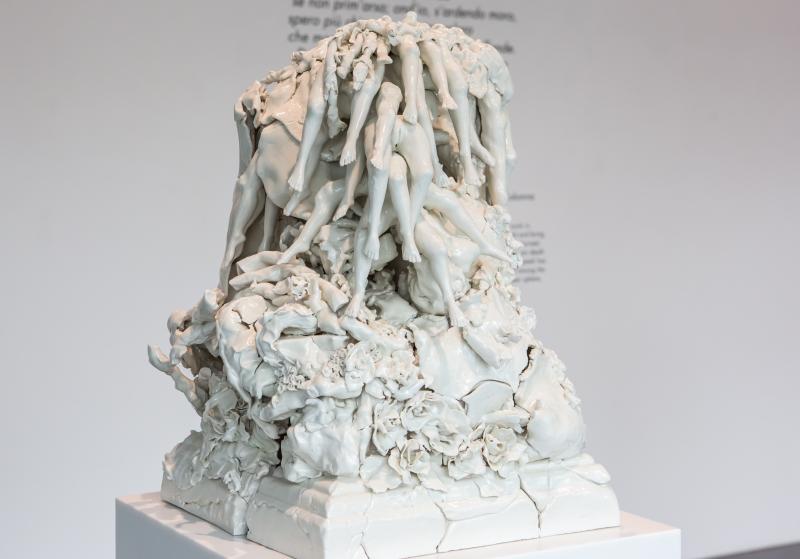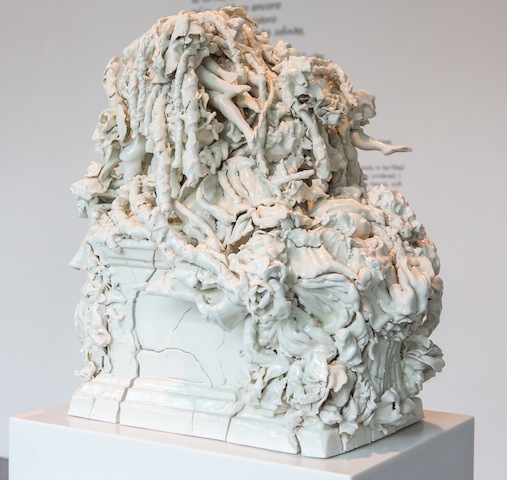Rachel Kneebone, Brighton Festival | reviews, news & interviews
Rachel Kneebone, Brighton Festival
Rachel Kneebone, Brighton Festival
The artist's porcelain sculptures are both lyrical and macabre

In an oft quoted moment of self-deprecation, WH Auden once described his own face as looking like “a wedding cake left out in the rain”. But the poet might have thought twice if confronted with the Porcelain confections of Rachel Kneebone. The London-based artist has brought three of her sculptures to the gallery of the University of Brighton; each one piles flora, vines and body parts onto a tomb-like plinth.
Look closer and delicate flowers dissolve into less seemly clumps of undergrowth. Tendrils look like entrails one moment, the next like spines, or like rope binding the whole production in place. And, as if freshly exhumed, slender female legs emerge before your eyes. In a poignant touch, you can make out toenails. Here and there you find a crack in the base or a gap in the thicket, through which you glimpse a hollow interior, as if the towering array might at any moment collapse.
The perfect legs bring to mind a dismembered Barbie. Elsewhere the creepy female torsos of Hans Bellmer are recalled. White orb-like belly and butchered joints nestle amid the confusion, ready to increase your sense of horror. Like Bellmer in the 1930s, Kneebone might well have found favour with the Surrealists. Her work is certainly dark and dream-like.
Today, it is hard to guess at Kneebone’s peers. A recent survey of figurative sculpture at the Hayward Gallery (The Human Factor) revealed nothing quite like her effusive vision. Perhaps the bulbous clay sculptures of Rebecca Warren share a sense of bodily excess. That show confirmed that the human form has, for decades now, been back in business. And once again we have a sculptural landscape which reflects a classical tradition.
 Poetry is the best way in here. Kneebone present two sonnets by Michelangelo, which can be read on the wall. These evoke the romance of the workshop, and the use of fire and mould, both of which this contemporary sculptor must use to bring her creations to life. But parallels between the Renaissance master and his modern admirer should end there. There is nothing Apollonian about Kneebone’s vision. If Michelangelo’s most famous slave enjoys a dignified death, Kneebone’s carnage of female parts call to mind a mass grave.
Poetry is the best way in here. Kneebone present two sonnets by Michelangelo, which can be read on the wall. These evoke the romance of the workshop, and the use of fire and mould, both of which this contemporary sculptor must use to bring her creations to life. But parallels between the Renaissance master and his modern admirer should end there. There is nothing Apollonian about Kneebone’s vision. If Michelangelo’s most famous slave enjoys a dignified death, Kneebone’s carnage of female parts call to mind a mass grave.
It was Theodor Adorno who said “To write poetry after Auschwitz is barbaric”. But even though conjuring the worst moments of human history, Kneebone’s show remains defiantly lyrical. As Ali Smith, curator of this year’s Brighton Festival, has said: “Gravity meets lightness, graveness meets delight.” What looks at first good enough to eat, reveals itself to be more like a landslide in an untended cemetery. If we dine, we do so amid the ruins. If we mourn, we don’t know where to begin.
Share this article
The future of Arts Journalism
You can stop theartsdesk.com closing!
We urgently need financing to survive. Our fundraising drive has thus far raised £49,000 but we need to reach £100,000 or we will be forced to close. Please contribute here: https://gofund.me/c3f6033d
And if you can forward this information to anyone who might assist, we’d be grateful.

Subscribe to theartsdesk.com
Thank you for continuing to read our work on theartsdesk.com. For unlimited access to every article in its entirety, including our archive of more than 15,000 pieces, we're asking for £5 per month or £40 per year. We feel it's a very good deal, and hope you do too.
To take a subscription now simply click here.
And if you're looking for that extra gift for a friend or family member, why not treat them to a theartsdesk.com gift subscription?
more Visual arts
 'We are bowled over!' Thank you for your messages of love and support
Much-appreciated words of commendation from readers and the cultural community
'We are bowled over!' Thank you for your messages of love and support
Much-appreciated words of commendation from readers and the cultural community
 Folkestone Triennial 2025 - landscape, seascape, art lovers' escape
Locally rooted festival brings home many but not all global concerns
Folkestone Triennial 2025 - landscape, seascape, art lovers' escape
Locally rooted festival brings home many but not all global concerns
 Sir Brian Clarke (1953-2025) - a personal tribute
Remembering an artist with a gift for the transcendent
Sir Brian Clarke (1953-2025) - a personal tribute
Remembering an artist with a gift for the transcendent
 Emily Kam Kngwarray, Tate Modern review - glimpses of another world
Pictures that are an affirmation of belonging
Emily Kam Kngwarray, Tate Modern review - glimpses of another world
Pictures that are an affirmation of belonging
 Kiefer / Van Gogh, Royal Academy review - a pairing of opposites
Small scale intensity meets large scale melodrama
Kiefer / Van Gogh, Royal Academy review - a pairing of opposites
Small scale intensity meets large scale melodrama
 Jenny Saville: The Anatomy of Painting, National Portrait Gallery review - a protégé losing her way
A brilliant painter in search of a worthwhile subject
Jenny Saville: The Anatomy of Painting, National Portrait Gallery review - a protégé losing her way
A brilliant painter in search of a worthwhile subject
 Abstract Erotic, Courtauld Gallery review - sculpture that is sensuous, funny and subversive
Testing the boundaries of good taste, and winning
Abstract Erotic, Courtauld Gallery review - sculpture that is sensuous, funny and subversive
Testing the boundaries of good taste, and winning
 Edward Burra, Tate Britain review - watercolour made mainstream
Social satire with a nasty bite
Edward Burra, Tate Britain review - watercolour made mainstream
Social satire with a nasty bite
 Ithell Colquhoun, Tate Britain review - revelations of a weird and wonderful world
Emanations from the unconscious
Ithell Colquhoun, Tate Britain review - revelations of a weird and wonderful world
Emanations from the unconscious
 Rachel Jones: Gated Canyons, Dulwich Picture Gallery review - teeth with a real bite
Mouths have never looked so good
Rachel Jones: Gated Canyons, Dulwich Picture Gallery review - teeth with a real bite
Mouths have never looked so good
 Yoshitomo Nara, Hayward Gallery review - sickeningly cute kids
How to make millions out of kitsch
Yoshitomo Nara, Hayward Gallery review - sickeningly cute kids
How to make millions out of kitsch
 Hamad Butt: Apprehensions, Whitechapel Gallery review - cool, calm and potentially lethal
The YBA who didn’t have time to become a household name
Hamad Butt: Apprehensions, Whitechapel Gallery review - cool, calm and potentially lethal
The YBA who didn’t have time to become a household name

Add comment